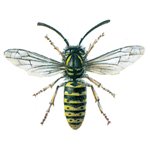
Wasp or hornet
Usually there is no doubt. When we talk about the wasp and its nest, we talk about the familiar black and yellow insect with that recognisable waist. The only problem is that there are other kinds of wasps like wood wasps, sawflies and many more. If you want to be accurate, you use the name hornet on the social species that belong to the family Vespidae.
We have seven species of social, community-forming, hornets in Northern Europe. They are very similar and live the same kind of life. Only the big hornet Vespa crabro, that is twice as large as its relatives, stand out.
A year in a wasp society In autumn a number of new queens and males are born in the nest. They swarm out and mate. Males die soon, but the fertilised young female wasps start looking for a reasonably sheltered place for them to spend winter. It may be in a hollow tree or a moss pillow, but often they find a good place in or on a house, in a crawl space or in an attic. If the nest warms up during winter, they wake up, and this explains the sudden appearance of dull wasps when an otherwise cool room is heated up in the middle of winter.
But when everything is right, they are awakened by the spring sun and flies out in mid-April. The new queen now gets busy. She must eat sugar and she must find a suitable place to found a new society. And our houses offer great places for wasps’ nests. Other wasps prefer holes in the ground, maybe an abandoned mouse’s nest, or a hollow tree, as the wood wasps prefer. She then start building the first nest, spherical, about the size of a ping pong ball. It contains 10-20 hexagonal cells and she lays an egg in each. When the eggs hatch, she must fetch food for the larvae, and only after the first litter of workers hatches about a month later, the queen can relax and concentrate on laying eggs. The workers are now taking over the work of expanding the nest and fetch feed for the new larvae. It is a vulnerable period and if the weather is cold, many queens die before they are finished with the work, and that means a year with only few wasps.
The nest is simply made of paper. The material is produces by the hornets by rasping fine fibres of plant stems and wood. They chew it with saliva until it gets the right texture and can be built into the nest, where it is needed. Actually it was hornets that inspired the first attempts to manufacture the paper we know today, and which replaced the paper that was made from old rags.
The feed for the larvae is meat. Wasps are hunters who catch flies, butterflies, honey bees and other insects in the air. They kill large prey with their sting. The part the prey, and chew it to round feed buns. They can also cut chunks of carrion or retrieve small pieces of roast from lunch tables. When they feed the larvae with these meat buns the larvae regurgitate a drop of a sugary substance. The adult wasps eat this. It gives them energy and perhaps even motivation to care for the larvae.
That is the summer in the wasps’ lives. Their community continues to grow and it can grow to be the size of a football and contain 5-6000 individuals in September. It is then the new queens and males are born and leave the nest, and little by little the community collapses; the workers stop working, and they no longer feed the larvae.
In November the nest is completely dead and hangs back as nothing but a hollow shell. The problem for wasps (hornets) in these latitudes is that they do not, like the honey bees, store food for the cold months, and then must start fresh every spring.
Wasps rarely occur as pests and in most cases you can live harmoniously as neighbour to a wasp’s nest. But if you are allergic to their stings or they appear in large numbers in a nursery, or if there simply are so many that it becomes really annoying, it is of course reasonable enough to find the nest and defuse it.
A wasp’s nest can be defused in many ways. If you can get to the hole at the bottom of the nest, it is a safe method to spray the hole and fill the nest with a liquid containing pyrethroid of a kind. If the nest is in a wall cavity or perhaps in a hole in the ground, it is possible to dust the place where the wasps come in and out with an insect powder of some kind, so that the wasps get infected with the powder when passing this point. If the nest is somewhere free of the house, where it is safe to use open fire, it is of course a possibility to burn it , perhaps using a rag with kerosene on a stick.
If you are frequently annoyed by wasps in your house, it may help to mount dense insect screens over the places, where the queens often find their ways in, and it may be a good idea to install insect screens in the vents to the crawl space in the spring.




